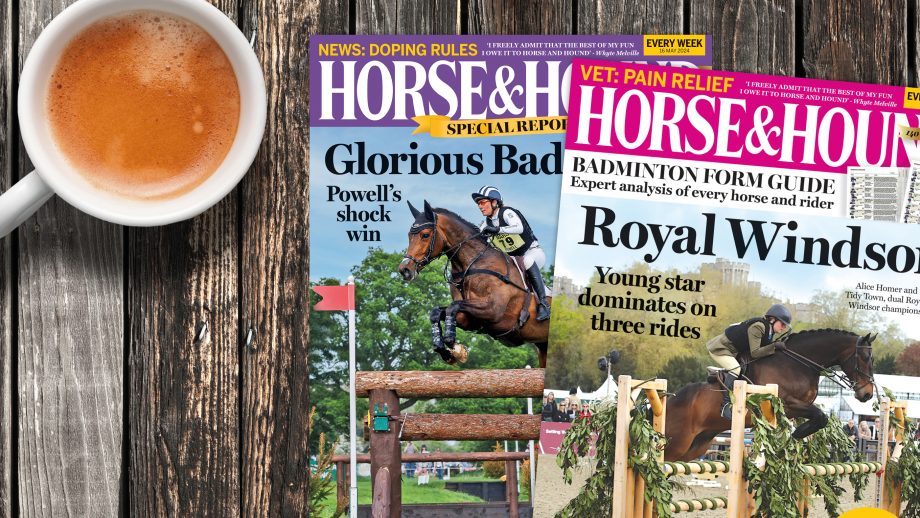For those who have a tendency to go into the college and not using a plan of what to do, spend half an hour trotting absent-mindedly in straight traces and circles and put your horse away with out an excessive amount of satisfaction or sense of enchancment, you’re not alone. Many people don’t have a lot of a construction to our education periods.
Whereas giant arenas, fancy jumps and poles are the dream, most riders make do with a 20x40m college – or a area – for our flatwork. Nonetheless, such limitations shouldn’t hamper our progress. In these super-simple coaching workout routines with Mary King, she exhibits us how all you want is room to journey a 20m circle and a little bit of self-discipline.
Slightly than following intricate patterns and sophisticated workout routines, these work on doing the fundamentals rather well.
Coaching with Mary King
1. Rider place
Intention: to have a greater seat and be extra balanced for all disciplines.
While you journey a 20m circle, it’s an opportunity to judge your place and enhance it. We naturally give attention to our horse and its approach of going, however we’re a serious a part of the equation. Mary suggests using on a circle in trot, analysing every a part of your physique to evaluate whether or not you’re within the appropriate place. Then make a transition to stroll, whereas sustaining the identical good place.
Mary says: “Consider a rider whose place you actually admire, and attempt to channel them as you journey across the circle.
“Carl Hester’s tip is to make the entrance of your physique longer, fairly than simply sitting up tall.”
Head: Mary advises holding your head straight, and looking out immediately forward, not down in the direction of the bottom.
“Don’t look to the within, look between the ears, ahead and in entrance of you, not turning an excessive amount of.
Palms: “Your arms shouldn’t be going up and down together with your physique as you rise to the trot,” says Mary. “It’s best to be capable of maintain your arms so they aren’t resting on the withers, and they need to keep nonetheless. Look down at them as you’re trotting alongside to see if you’re holding them nonetheless.”
Mary’s tip is to maintain a “good bend within the elbow to assist soften your arms”.
Mary encourages riders to look right down to see if their arms are nonetheless – however not resting on the withers – with a bend within the elbow, earlier than wanting forward once more. Credit score: Emma Herrod
Decrease leg: Mary rides dressage along with her stirrups 10 holes decrease than for cross-country. No matter size your stirrups, hold your ankles relaxed so your heels are softly down, and use your calf to offer leg aids clearly fairly than nagging together with your heels.
“In case your horse is lazy, don’t simply hold urgent or your heels will rise,” she advises. “Give extra of a slap together with your decrease leg, then hold the leg nonetheless.”
2. Transitions
Intention: to make your horse extra responsive, enabling you to make transitions at actual markers.
Mary repeatedly makes use of this train when using within the college, practising quarter-hour of walk-trot, trot-walk and halt-walk-halt transitions.
She advises utilizing markers – which generally is a sure tree or fence publish if you happen to don’t have enviornment letters – so to put together upfront the place you need your horse to make a transition, and be correct.
“When going from stroll to trot, ensure that the stroll is energetic sufficient in order that whenever you ask for trot together with your leg, they go on immediately,” she says. “The horse ought to keep in a great place of their head and neck, not lifting up.
“If it takes some time till they make the transition, you have to work at getting it sharper. Hold your decrease leg down, not swinging again.”
The downward transition additionally requires preparation to make sure it occurs on the marker and never a number of strides after.
“It’s best to all the time consider using ahead into stroll or any downward transition,” says Mary. “Put together, not being in robust together with your hand, in order that the horse is mild and up in entrance. You don’t need him knocking down into stroll, however coming ahead so push just a little together with your leg to maintain their hindlegs lively.”

How to not do it! Mary King demonstrates what occurs if the horse pulls you ahead in a downward transition, occurring to the forehand fairly than holding the hindleg lively. Credit score: Emma Herrod
3. Making transitions throughout the canter
Intention: to encourage the horse to pay attention and react.
This coaching with Mary King train works in canter on a 20m circle, going from working to medium canter and again once more. They secret’s to not break into trot.

This train practises opening up the stride from working to medium canter, and condensing it again to encourage the horse to pay attention and be reactive. Credit score: Emma Herrod
“It’s particularly good for horses which are a bit behind the leg,” says Mary. “It’s a tough train on a quiet horse.”
Begin on a 20m circle in a working canter, ensuring you could have loads of power. Then go ahead to medium canter for half a circle, and again to working canter. Do one other circle, after which once more into medium. The horse ought to go ahead whenever you ask and “present an actual distinction of their stride”.
“You need the horse to speed up, not simply going sooner however to open up their stride so they’re masking extra floor.”
Mary suggests how your mindset must be to open up the stride on a lazier sort.
“Suppose, ‘let’s go for a gallop’, to indicate a change in stride,” she says.
She explains the aids for condensing the stride once more.
“Then put together to return again to working canter,” she says. “Deliver your higher physique again a bit, shoulders again, to point one thing goes to occur.
“Shut your fingers on the reins, however hold your leg on as you don’t need the horse to trot. Don’t simply pull the reins or they are going to sluggish up on their forehand.
“Hold the canter brief however energetic.”
Mary’s tip for horses that break into trot or discover it exhausting to gather is to “make the circle barely smaller – 15m – which can assist them to gather because it encourages the hindlegs to have interaction”.
Subsequent time you’re in need of inspiration as you trot aimlessly spherical the college, think about you’re coaching with Mary King and your session ought to convey you larger satisfaction – and progress.
Did you discover this text useful? You might also prefer to learn…

Credit score: Jess Images

Credit score: Jess Images

Credit score: Elli Birch/Bootsandhooves



Credit score: Future









